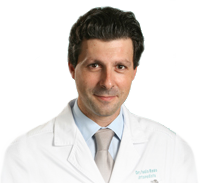- /
- Anca infantil /
- Doenças da anca infantil
Infant hip disease
The most frequent pathologies in the child´s hip can be clustered into:
- Inflammatory diseases
- Infectious diseases
- Pain caused by “over use”
- Development diseases
Transient synovitis of the hip: (inflammation)
Usually affects children between 3 and 8 years of age. Manifests itself with groin pain with sudden onset, difficulty in walking and movement limitation. Normally there is no fever. Possible causes for this condition include a previous viral infection, allergic reactions or trauma. The pain results from the existence of an inflammation of the synovial membrane (membrane lining the inside hip). There may be an increase of fluid within the joint that distends the capsule and increases the limitation of movement. The treatment consists of bed rest for one week, anti-inflammatory medication and limitation of physical activity for at least 3 weeks.
Septic arthritis of the hip: (infection
Is a serious disease that requires early diagnosis and effective treatment. The cause is usually a bacterial infection that can lodge itself in the articulation by blood spreading from another location. The joint infection usually leads to the appearance of intra articular pus and joint destruction. Normally it has a rapid onset and is invariably accompanied by systemic signs: fever and alteration of blood tests - white blood cells, sedimentation rate and C-reactive protein increase. There is typically a large muscle spasm around the hip. The child is very complaining and any attempt to mobilize the hip triggers pain. Treatment is urgent and often with surgical drainage of pus and intra articular lavage. The liquid collected should be analyzed to make sure which bacteria caused the infection and to direct adequate treatment with antibiotics. The prognosis may not be favorable if the bacterium is too aggressive or resistant to antibiotics.
“Over use”:
Lesions due to functional overload of the hip (excess sport or other situations where the growing hip is overloaded) can be classified as intra-articular lesions and extra articular lesions.
- Intra-articular lesions in hip with normal morphology are more difficult to diagnose. Usually occurs in children who have a lot of "elasticity" and a lot of mobility in the hip. In these situations there may be a mechanism of femoroacetabular impingement by excessive mobility with compression of the labrum (fig.1) and cartilage lesion (see section "What is femoroacetabular impingement?").
| fig.1: MRI of a young 13 year old gymnast showing degenerative changes in the structure of the labrum (fewer black color indicated by the yellow arrow) of the labrum by hypermobility. The mechanism is its compression by femoral head-neck amplitudes of movement greater than normal. |
- extra-articular lesions of the thigh muscles and adductors are relatively frequent in young people with sporting activity, especially during the adolescent growth surge, when bone growth is faster than the musculotendinous growth. Muscle lesions are also common. Fractures by apophysial pullout (where the tendons are inserted) are common in young athletes and usually occurs by repetitive or excessive muscle traction. Pelvis apophyses are more affected: iliac crest (abdominal muscles), anterior superior iliac spine (Sartorius muscle), anterior inferior iliac spine (femoral rectum) (fig. 2), ischial tuberosity (ischiotibial muscles) and lesser trochanter (iliopsoas muscles). The treatment may be surgery or not, depending on the size of the bone fragment.
| fig. 2: Radiograph of a 14 year old athlete who shows a pullout of the anterior inferior iliac spine by the anterior rectus muscle (quadriceps) |
Perthes disease (see section "Perthes Disease").
Upper epiphysiolysis of the femur (see section "Epiphysiolysis of the upper femur").
Legal Notice
CirurgiaConservadoradAnca.com has been developed for the purpose of providing information on the various hip pathologies to patients, physicians and other healthcare professionals. The information contained in this website cannot replace a proper clinical assessment. May not in any way be used to make a diagnosis or suggest treatment. This website has no interest or is in any way associated with companies that sell medications or surgical equipment.
The content of the website is for informative purposes only and its use is the sole responsibility of users.
All submitted content is intelectual property of the author. It is expressly forbidden to copy and use without permission of the same.
It is not allowed to make connections to this website as well as framing, mirroring and link directly to specific subpages (deep linking) without the prior written consent of CirurgiaConservadoraAnca.com

